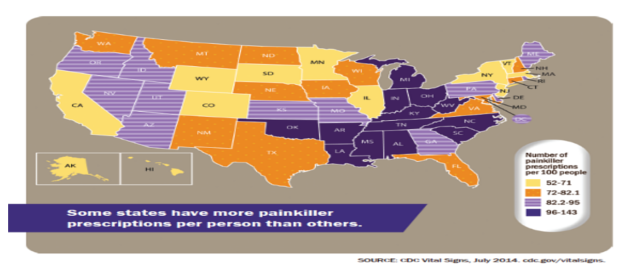Opioid painkiller prescribing varies widely among states
Where you live makes a difference
Health care providers in some states prescribed far more painkillers than those in other states.
Health care providers wrote 259 million prescriptions for opioid painkillers in 2012 – many more in some states than in others – according to a Vital Signs report released today by the Centers for Disease Control and Prevention that highlights the danger of overdose. The report also has an example of a state that reversed its overdose trend.
Health care providers in the highest prescribing state, Alabama, wrote almost three times as many of these prescriptions per person as those in the lowest prescribing state, Hawaii. Most of the highest prescribing states were in the South. Previous research has shown that regional variation in use of prescriptions cannot be explained by the underlying health status of the population.
The Vital Signs report also contains a study highlighting the success of Florida in reversing prescription drug overdose trends. Results showed that after statewide legislative and enforcement actions in 2010 and 2011, the death rate from prescription drug overdose decreased 23 percent between 2010 and 2012. Florida officials had taken these actions in response to a 28 percent increase in the drug overdose death rate over the preceding years (2006-2010).
Declines in death rates in Florida for specific prescription painkillers (oxycodone, methadone, and hydrocodone) and sedatives paralleled declines in prescribing rates for those drugs. This report was based on Florida Medical Examiners Commission data from 2006 to 2012 and IMS Health National Prescription Audit data from 2008 to 2012.
“Prescription drug overdose is epidemic in the United States. All too often, and in far too many communities, the treatment is becoming the problem,†said CDC Director Tom Frieden, M.D., M.P.H. “Overdose rates are higher where these drugs are prescribed more frequently. States and practices where prescribing rates are highest need to take a particularly hard look at ways to reduce the inappropriate prescription of these dangerous drugs.â€
For this Vital Signs report, CDC analyzed 2012 prescribing data collected from retail pharmacies in the United States by a commercial vendor. CDC calculated prescribing rates by state for various types of opioid painkillers.
Key findings include:
•Southern states – Alabama, Tennessee, and West Virginia in particular – had the most painkiller prescriptions per person.
•The Northeast, especially Maine and New Hampshire, had the most prescriptions per person for long-acting/extended-release painkillers and for high-dose painkillers.
•State variation was the greatest for oxymorphone (a specific type of painkiller), among all prescription painkillers. Nearly 22 times as many prescriptions were written for oxymorphone in Tennessee as were written in Minnesota.
“We know we can do better. State variation in prescribing shows us that the overprescribing of opioids can be reduced safely and feasibly,†said Daniel M. Sosin, M.D., M.P.H., F.A.C.P., acting director of CDC’s National Center for Injury Prevention and Control. “Improving how opioids are prescribed will help us prevent the 46 prescription painkiller overdose deaths that occur each day in the United States.â€
Previous research has shown that state variation does not necessarily translate to better health outcomes or patient satisfaction. In fact, high rates of use might produce worse outcomes.
Steps that states can take to address the overprescribing of painkillers include:
•Considering ways to increase use of prescription drug monitoring programs, which are state-run databases that track prescriptions for painkillers and can help find problems in overprescribing. Impact of these programs is greater when they make data available in real time, are universal (used by all prescribers for all prescriptions for all controlled substances), and are actively managed (for example, send alerts to prescribers when problems are identified).
•Considering policy options, including laws and regulation, relating to pain clinics to reduce prescribing practices that are risky to patients.
•Evaluating their own data and programs and considering ways to assess their Medicaid, workers’ compensation programs, and other state-run health plans to detect and address inappropriate prescribing of painkillers.
•Identifying opportunities to increase access to substance abuse treatment and considering expanding first responder access to naloxone, a drug used when people overdose.

